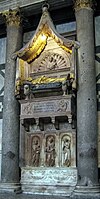Portal:Catholic Church
Introduction The Catholic Church, also known as the Roman Catholic Church, is the largest Christian church, with 1.39 billion baptized Catholics worldwide as of 2022. It is among the world's oldest and largest international institutions, and has played a prominent role in the history and development of Western civilization. The church consists of 24 sui iuris churches, including the Latin Church and 23 Eastern Catholic Churches, which comprise almost 3,500 dioceses and eparchies located around the world. The pope, who is the bishop of Rome, is the chief pastor of the church. The Diocese of Rome, known as the Holy See, is the central governing authority of the church. The administrative body of the Holy See, the Roman Curia, has its principal offices in Vatican City, a small independent city-state and enclave within the Italian capital city of Rome, of which the pope is head of state. The core beliefs of Catholicism are found in the Nicene Creed. The Catholic Church teaches that it is the one, holy, catholic and apostolic church founded by Jesus Christ in his Great Commission, that its bishops are the successors of Christ's apostles, and that the pope is the successor to Saint Peter, upon whom primacy was conferred by Jesus Christ. It maintains that it practises the original Christian faith taught by the apostles, preserving the faith infallibly through scripture and sacred tradition as authentically interpreted through the magisterium of the church. The Roman Rite and others of the Latin Church, the Eastern Catholic liturgies, and institutes such as mendicant orders, enclosed monastic orders and third orders reflect a variety of theological and spiritual emphases in the church. Of its seven sacraments, the Eucharist is the principal one, celebrated liturgically in the Mass. The church teaches that through consecration by a priest, the sacrificial bread and wine become the body and blood of Christ. The Virgin Mary is venerated as the Perpetual Virgin, Mother of God, and Queen of Heaven; she is honoured in dogmas and devotions. Catholic social teaching emphasizes voluntary support for the sick, the poor, and the afflicted through the corporal and spiritual works of mercy. The Catholic Church operates tens of thousands of Catholic schools, universities and colleges, hospitals, and orphanages around the world, and is the largest non-government provider of education and health care in the world. Among its other social services are numerous charitable and humanitarian organizations. (Full article...) Selected article
 The Tomb of Antipope John XXIII is the marble tomb monument of Antipope John XXIII (Baldassare Cossa, c. 1360–1419), created by Donatello and Michelozzo for the Florence Baptistery adjacent to the Duomo. It was commissioned by the executors of Cossa's will after his death on December 22, 1419 and completed during the 1420s, establishing it as one of the early landmarks of Renaissance Florence. According to Ferdinand Gregorovius, the tomb is "at once the sepulchre of the Great Schism in the church and the last Papal tomb which is outside Rome itself".Cossa had a long history of cooperation with Florence, which had viewed him as the legitimate pontiff for a time during the Western Schism. The tomb monument is often interpreted as an attempt to strengthen the legitimacy of Cossa's pontificate by linking him to the spiritually powerful site of the Baptistry.The evocation of papal symbolism on the tomb and the linkage between Cossa and Florence have been interpreted as a snub to Cossa's successor Pope Martin V or vicarious "Medici self-promotion", as such a tomb would have been deemed unacceptable for a Florentine citizen.
Selected image
 The Seven Sacraments by Rogier van der Weyden (ca.1448) "The seven sacraments, Baptism, Confirmation or Chrismation, Eucharist, Penance, Anointing of the Sick, Holy Orders, and Matrimony, instituted by Christ and entrusted to the Church, are efficacious signs of grace perceptible to the senses. They assist individuals in their spiritual progress and growth in holiness. Selected biography
Did you know...
Related portalsFeast Day of May 22
Pope Leo XIII canonized Rita on 24 May 1900. Her feast day is celebrated on 22 May. At her canonization ceremony, she was bestowed the title of "Patroness of Impossible Causes," while in many Catholic countries, Rita came to be known as the patroness of abused wives and heartbroken women. Her bodily remains lie in the Basilica of Santa Rita da Cascia. (Full article...)
Selected quote
News
SubcategoriesTopics
The Holy Bible:
Particular Churches (grouped by liturgical rite):
Things you can do
External resourcesWikiProjectsAssociated WikimediaThe following Wikimedia Foundation sister projects provide more on this subject:
Discover Wikipedia using portals |


































